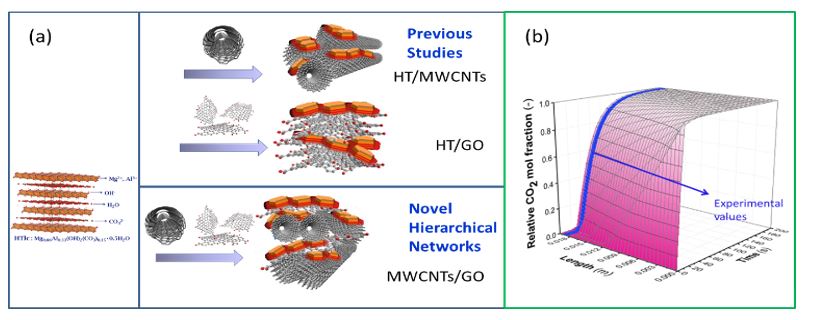Video Article Open Access
Novel Hierarchical Networks as Support for Hydrotalcites for Pre-Combustion CO2 Capture
D. Iruretagoyena*, P. Fennell, R. Pini
Department of Chemical Engineering, Imperial College London, United Kingdom, SW7 2AZ
Vid. Proc. Adv. Mater., Volume 3, Article ID 2210358 (2022)
DOI: 10.5185/vpoam.2022.10358
Publication Date (Web): 15 Oct 2023
Copyright © IAAM
Graphical Abstract

Abstract
Over the last decades there has been widespread concern about the increasing concentration of carbon dioxide in the atmosphere due to anthropogenic activities, with fossil fuel combustion being the main CO2 source [1]. There is, therefore, strong motivation in developing suitable processes for carbon dioxide capture and storage (CCS). In this regard, pre-combustion carbon capture stands out as one of the most promising strategies for CCS, in which a developing technology is sorption enhanced H2 production (SE-H2) operating between 573 and 773 K. So far hydrotalcites (HTs) are regarded as the most promising group of CO2 adsorbents for SE-H2 since they show good performance in the temperature range of interest, exhibiting fast kinetics, high selectivity in the presence of water and requiring relatively low energy to be regenerated compared to other adsorbents. However, a major drawback of HTs for commercial use is their relatively low adsorption capacities, and also improvement in multicycle stability is needed for their use in pressure and temperature swing applications.
In previous studies, we demonstrated that the CO2 adsorption performance of HTs can be improved by supporting them on multi-walled carbon nanotubes (MWCNTs) and graphene oxide (GO) [2,3]. Significant enhancement in terms of intrinsic capacity and regenerability was observed using these carbon materials, however thermal degradation of the support was observed over extended multicycles. In this contribution, we report the synthesis of novel HT/MWCNTs/GO hybrids and GO aerogels with different loadings and their adsorption performance under relevant SE-H2 conditions. We show that the use of these networks confer significant advantages in terms of enhanced intrinsic adsorption capacity, thermal stability, kinetics and heat and mass transport characteristics compared to unsupported HT and previously reported HT/MWCNTs and HT/GO adsorbents. The presence of an open, accessible, high surface area network stabilises the final adsorbent, minimising the deactivation and sintering effects normally observed for the unsupported HT. The concept of these networks as substrate can be readily extended to other adsorbent materials (e.g., SBA15 based) particularly where problems of sorbent degradation over use are still present [4]. The adsorption kinetics of the hybrids can be described by a linear driving force dynamic model, Figure 1. The information generated in this study serves as a basis for the design of pre-combustion CO2 capture units.
Keywords
Hydrotalcites, hierarchical networks, pre-combustion CO2 capture, graphene aerogels, multi-walled carbon nanotubes.
Acknowledgement
This work is supported by the Imperial College Research Fellowship. The authors are grateful with M. Shaffer, R. Menzel, N. Shah, D. Chadwick for discussions.
References
- Committee on Climate Change, Next steps for UK heat policy, 2016. (https://www.theccc.org.uk/wp-content/uploads/2016/10/Next-steps-for-UK-heat-policy-Committee-on-Climate-Change-October 2016.pdf).
- D. Iruretagoyena, Springer Theses, Switzerland, 2016.
- M. D. Marco, M. Shaffer, et al., Carbon, 2017, 123, 616-627.
- D. Iruretagoyena, D. Chadwick, et al., J. CO2 Utilization, 2018, 24, 73-80.
Biography
Diana Iruretagoyena obtained her BSc. and MSc. in Chemical Engineering at Universidad Nacional Autonoma de Mexico. She received her PhD in the Department of Chemical Engineering (2014) at Imperial College London, where she currently works as Research Fellow. Her research focuses on the interfaces of reaction engineering, applied catalysis, separation processes and materials science combining laboratory experiments and modelling work. Her work involves the synthesis, characterization and testing of a wide range of nanostructured materials including carbon nanotubes and graphene composites, inorganic (hydro) oxides and supported metal catalysts. The aim is to understand and tune the chemical properties and morphology of these materials so they can be successfully applied in areas such as adsorption of CO2 and organosulfur compounds, and catalytic production of hydrogen and chemical intermediates from bio-based feedstocks. Diana’s research has resulted in relevant scientific publications, and presentations, and she is part of important Editorial Boards. In addition, she has received prestigious awards in recognition to the excellence of her research in the field of Materials Science including the Julia Higgins Centenary Prize from the Department of Chemical Engineering, Imperial College London and the Springer Theses Award from Springer.
Video Proceedings of Advanced Materials

Upcoming Congress



